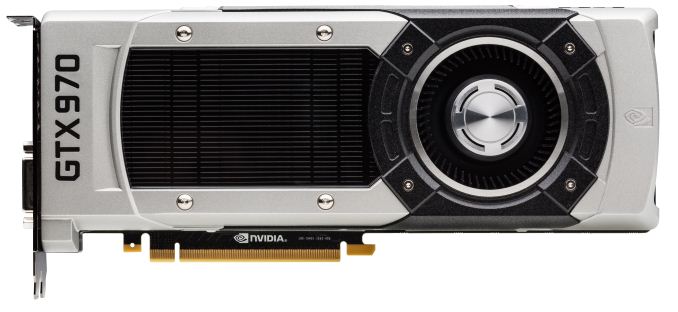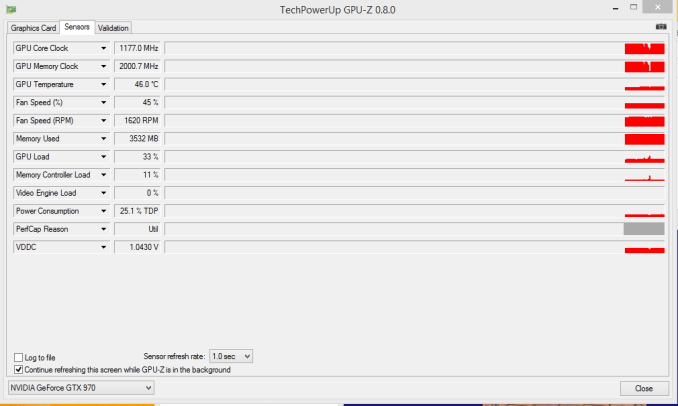NVIDIA Publishes Statement on GeForce GTX 970 Memory Allocation
by Ryan Smith on January 24, 2015 8:00 PM EST
On our forums and elsewhere over the past couple of weeks there has been quite a bit of chatter on the subject of VRAM allocation on the GeForce GTX 970. To quickly summarize a more complex issue, various GTX 970 owners had observed that the GTX 970 was prone to topping out its reported VRAM allocation at 3.5GB rather than 4GB, and that meanwhile the GTX 980 was reaching 4GB allocated in similar circumstances. This unusual outcome was at odds with what we know about the cards and the underlying GM204 GPU, as NVIDIA’s specifications state that the GTX 980 and GTX 970 have identical memory configurations: 4GB of 7GHz GDDR5 on a 256-bit bus, split amongst 4 ROP/memory controller partitions. In other words, there was no known reason that the GTX 970 and GTX 980 should be behaving differently when it comes to memory allocation.

GTX 970 Memory Allocation (Image Courtesy error-id10t of Overclock.net Forums)
Since then there has been some further investigation into the matter using various tools written in CUDA in order to try to systematically confirm this phenomena and to pinpoint what is going on. Those tests seemingly confirm the issue – the GTX 970 has something unusual going on after 3.5GB VRAM allocation – but they have not come any closer in explaining just what is going on.
Finally, more or less the entire technical press has been pushing NVIDIA on the issue, and this morning they have released a statement on the matter, which we are republishing in full:
The GeForce GTX 970 is equipped with 4GB of dedicated graphics memory. However the 970 has a different configuration of SMs than the 980, and fewer crossbar resources to the memory system. To optimally manage memory traffic in this configuration, we segment graphics memory into a 3.5GB section and a 0.5GB section. The GPU has higher priority access to the 3.5GB section. When a game needs less than 3.5GB of video memory per draw command then it will only access the first partition, and 3rd party applications that measure memory usage will report 3.5GB of memory in use on GTX 970, but may report more for GTX 980 if there is more memory used by other commands. When a game requires more than 3.5GB of memory then we use both segments.
We understand there have been some questions about how the GTX 970 will perform when it accesses the 0.5GB memory segment. The best way to test that is to look at game performance. Compare a GTX 980 to a 970 on a game that uses less than 3.5GB. Then turn up the settings so the game needs more than 3.5GB and compare 980 and 970 performance again.
Here’s an example of some performance data:
GeForce GTX 970 Performance Settings GTX980 GTX970 Shadows of Mordor
<3.5GB setting = 2688x1512 Very High
72fps
60fps
>3.5GB setting = 3456x1944
55fps (-24%)
45fps (-25%)
Battlefield 4
<3.5GB setting = 3840x2160 2xMSAA
36fps
30fps
>3.5GB setting = 3840x2160 135% res
19fps (-47%)
15fps (-50%)
Call of Duty: Advanced Warfare
<3.5GB setting = 3840x2160 FSMAA T2x, Supersampling off
82fps
71fps
>3.5GB setting = 3840x2160 FSMAA T2x, Supersampling on
48fps (-41%)
40fps (-44%)
On GTX 980, Shadows of Mordor drops about 24% on GTX 980 and 25% on GTX 970, a 1% difference. On Battlefield 4, the drop is 47% on GTX 980 and 50% on GTX 970, a 3% difference. On CoD: AW, the drop is 41% on GTX 980 and 44% on GTX 970, a 3% difference. As you can see, there is very little change in the performance of the GTX 970 relative to GTX 980 on these games when it is using the 0.5GB segment.
Before going any further, it’s probably best to explain the nature of the message itself before discussing the content. As is almost always the case when issuing blanket technical statements to the wider press, NVIDIA has opted for a simpler, high level message that’s light on technical details in order to make the content of the message accessible to more users. For NVIDIA and their customer base this makes all the sense in the world (and we don’t resent them for it), but it goes without saying that “fewer crossbar resources to the memory system” does not come close to fully explaining the issue at hand, why it’s happening, and how in detail NVIDIA is handling VRAM allocation. Meanwhile for technical users and technical press such as ourselves we would like more information, and while we can’t speak for NVIDIA, rarely is NVIDIA’s first statement their last statement in these matters, so we do not believe this is the last we will hear on the subject.
In any case, NVIDIA’s statement affirms that the GTX 970 does materially differ from the GTX 980. Despite the outward appearance of identical memory subsystems, there is an important difference here that makes a 512MB partition of VRAM less performant or otherwise decoupled from the other 3.5GB.
Being a high level statement, NVIDIA’s focus is on the performance ramifications – mainly, that there generally aren’t any – and while we’re not prepared to affirm or deny NVIDIA’s claims, it’s clear that this only scratches the surface. VRAM allocation is a multi-variable process; drivers, applications, APIs, and OSes all play a part here, and just because VRAM is allocated doesn’t necessarily mean it’s in use, or that it’s being used in a performance-critical situation. Using VRAM for an application-level resource cache and actively loading 4GB of resources per frame are two very different scenarios, for example, and would certainly be impacted differently by NVIDIA’s split memory partitions.
For the moment with so few answers in hand we’re not going to spend too much time trying to guess what it is NVIDIA has done, but from NVIDIA’s statement it’s clear that there’s some additional investigating left to do. If nothing else, what we’ve learned today is that we know less than we thought we did, and that’s never a satisfying answer. To that end we’ll keep digging, and once we have the answers we need we’ll be back with a deeper answer on how the GTX 970’s memory subsystem works and how it influences the performance of the card.











93 Comments
View All Comments
nuoh_my_god - Sunday, January 25, 2015 - link
I'm having issues as well. Only using 1080p, but using heavily modded Skyrim with 200+ mods and over 20GB of additional meshes and textures from mods. When i stay in the <3500 zone, i have smooth sailing with 45+ fps, no drops. As soon as the cards hits 3500, i start getting the worst stuttering ever, constant drops to 0fps but with normal fps in between. Also, never see more than 3550 utilization, while my friends 670 with 4gb can use up to 3900 with no stutters, just lower fps in general.2late2die - Monday, January 26, 2015 - link
If that is indeed the case then I apologize, but from the article above I didn't get that there was in fact an issue performance, all I saw was that diagnostic tools weren't reporting 4GB. If like you say there are indeed severe performance issues then yeah, that's definitely a problem.Lakku - Tuesday, February 3, 2015 - link
Plenty of people would be in an uproar because people like to complain. Fanboys also like to point out flaws in products they don't support. There hasn't been any assessment that shows a big drop in performance or frame times. People noticed it because they have OSD screens on their keyboards or programs showing VRAM use and noticed it was showing 3.5GB and not 4. There hasn't been proof of any performance issues.dcoca - Wednesday, January 28, 2015 - link
Dude when I bought this card I was under the impression that it had 64 rops and 2meg of l2 cash, I don't care if you, or anyone else says it's not needed or impacting performance not having that total: it's the fact that I spent 400 Canadian on specs issued by vendor, and partners.... it's like buying 4 core cpu, to only find out that it really is an i3 with ht....MikeMurphy - Saturday, January 24, 2015 - link
I'm likely wrong, but I can't help but think the Maxwell GPUs read and write 32-bit addresses..tuxfool - Saturday, January 24, 2015 - link
That doesn't explain why the GTX 980 doesn't have the same issue. Nor why this issue only affects some people or if only a few people have tested their cards?PernusBernus - Saturday, January 24, 2015 - link
Interesting... I have a 980 and I get the same drop in bandwidth: http://pastebin.com/UqDVxGXLPernusBernus - Saturday, January 24, 2015 - link
Just to clarify, I used the benchmark linked from Lazygamer's coverage of the same apparent issue: http://www.lazygamer.net/general-news/nvidias-gtx9...PernusBernus - Saturday, January 24, 2015 - link
Never mind, just realised that the last 300MB or so VRAM was conserved by the system...tabascosauz - Saturday, January 24, 2015 - link
As much as I appreciate the quick and detailed response from Nvidia, this doesn't improve their reputation a single bit in my book. Nvidia has never been one to play it safe with memory buses, always preferring to use their "revolutionary" texture compression algorithms to make up for shortcomings on the VRAM side.The GTX 550 Ti, GTX 660 and GTX 660 Ti come to mind when it comes to problems addressing VRAM. All of these cards featured a 192-bit GDDR5 interface, but all of these cards either came in 1GB/2GB configs instead of the expected 768MB/1.5GB/3GB configs. After the reviews here briefly discussed the feasibility of such an implementation, it seemed to be completely forgotten in no time. Unsurprisingly, the GTX 660 was pretty disappointing. Hopefully Nvidia has learned their lesson and will take steps to improve their work in this regard.